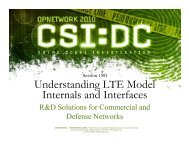Automated Axon Tracking of 3D Confocal Laser Scanning ...
Automated Axon Tracking of 3D Confocal Laser Scanning ...
Automated Axon Tracking of 3D Confocal Laser Scanning ...
You also want an ePaper? Increase the reach of your titles
YUMPU automatically turns print PDFs into web optimized ePapers that Google loves.
dataset in a direction normal to the orientation <strong>of</strong> the axon. This ensures that the axon crosssectionsdo not randomly appear and vanish in the cross-sectional image sequence due totheir orientation with respect to the imaging plane. Although relatively more expensive thanthe previously mentioned approach, this method does not require manual intervention exceptin the first cross-sectional slice where the user has to specify the centers <strong>of</strong> the axons.A situation where the proposed hybrid algorithm fails is when the axons completely overlapin the MIP image. In such a case, our algorithm does not detect a cross-over and hence will notswitch to the cross-sectional analysis. This way, one or some <strong>of</strong> the axons in the MIP imagemight remain untraced altogether. In such rare conditions, the problem can be circumvented byanalyzing the whole dataset using cross-sectional analysis. An interesting case one might comeacross is when the structure size approaches the voxel size. Our algorithm can still be applied insuch a case. As mentioned earlier in the paper, to segment the axon cross-section, we have t<strong>of</strong>irst detect the seed points. If the structure size approached the voxel size, the seed points canstill be detected since they are detected inside a window. The window parameters are determinedbased on the segmentation result <strong>of</strong> the previous size. If the window is properly defined, themean-shift algorithm can accurately determine the seed points. The guided region growingalgorithm or the watershed can then easily determine the boundary.5. ConclusionFrom the datasets presented in this paper, it can be seen that the images have high signal to noiseratio, which makes it relatively easy to segment axons as a whole from the background.However, in many instances, axons tend to get close to each other, which make the process <strong>of</strong>tracking difficult. Significant problems in segmentation and tracking also arise when theintensity <strong>of</strong> the axon becomes weak. The hybrid algorithm presented in this paper is able to34















